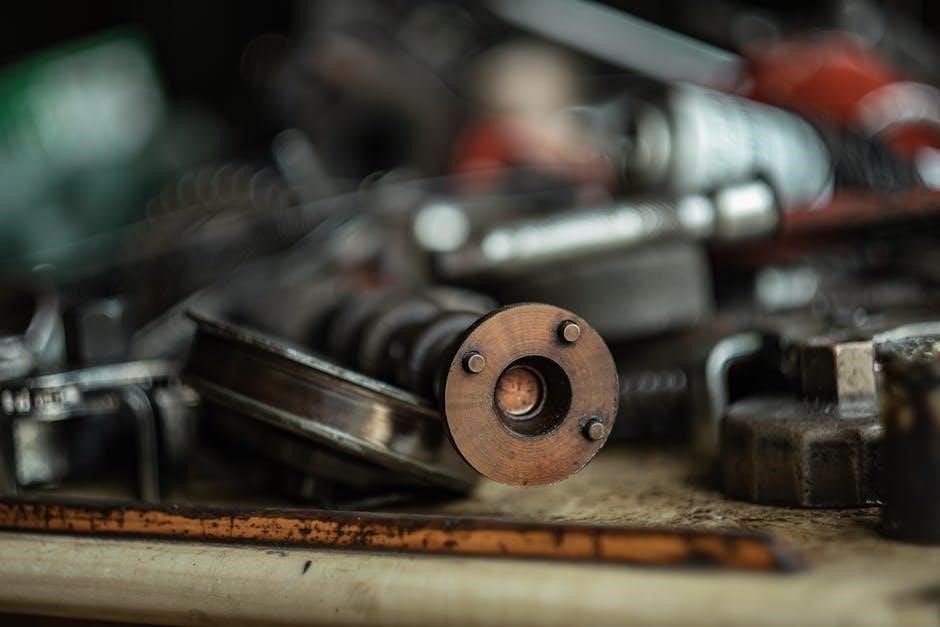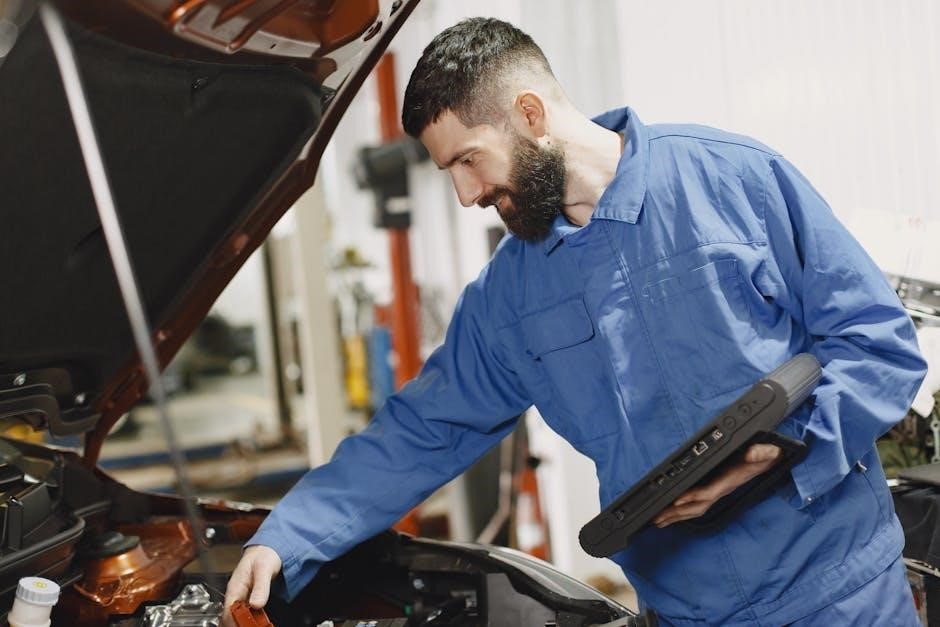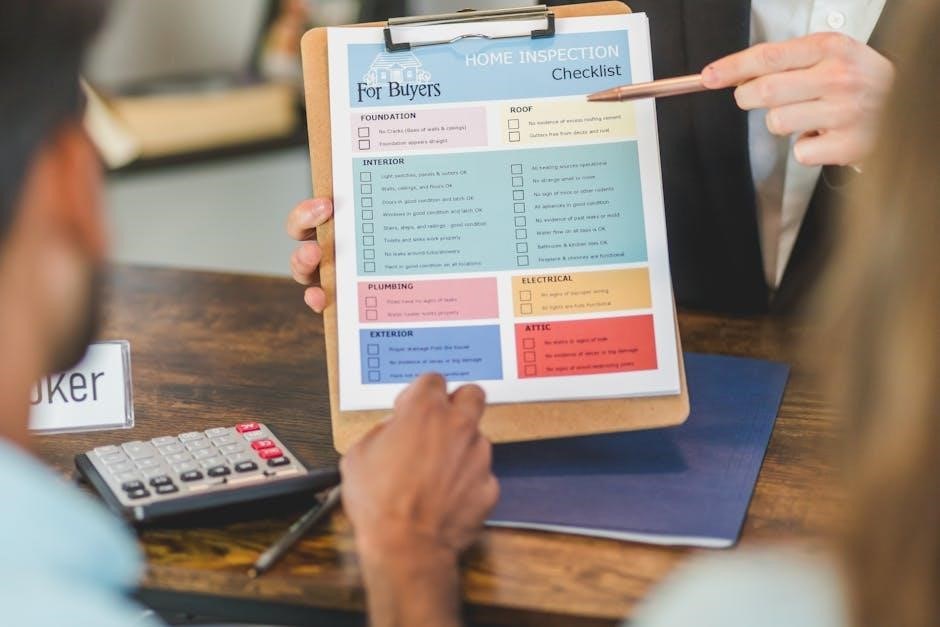Exterior Inspection
Check the RV’s exterior for damage, rust, or wear. Inspect the roof for leaks, seals, and structural integrity. Examine walls, siding, and decals for cracks or peeling. Evaluate tires for proper tread and inflation. Test windows and doors for sealing and functionality. Inspect propane, water, and electrical systems for leaks or damage. Ensure all external compartments open and close securely.
1.1. Roof Condition and Seals
Examine the roof for cracks, dents, or damaged panels. Check for signs of leaks, water stains, or soft spots. Inspect seals around vents, skylights, and edges for wear or gaps. Ensure all caulking is intact and free from cracks. Look for rust on metal components and verify that roof-mounted appliances are securely fastened. Test the integrity of roof seals by applying gentle pressure. Inspect the ceiling inside for water stains or sagging, indicating potential roof leaks. Ensure all vents and fans function properly and are free from debris. A thorough roof inspection is crucial to prevent costly water damage and maintain structural integrity.
1.2. Walls and Siding
Inspect the RV’s walls and siding for dents, cracks, or delamination. Check for signs of leaks, water damage, or rust, especially around seams and edges. Verify that all decals and paint are in good condition, with no peeling or fading. Ensure that siding panels are securely fastened and aligned properly. Look for any gaps or loose areas that could indicate poor maintenance or damage. Inspect the caulking around windows, doors, and joints for cracks or separation. Any damage to walls or siding can lead to structural issues or water intrusion, so it’s essential to address these points thoroughly during the inspection process.
1.3. Windows and Doors
Inspect all windows and doors for proper sealing, functionality, and damage. Check window seals and caulking for cracks or separation, ensuring they are watertight. Test door locks and hinges for smooth operation and security. Look for any signs of wear, dents, or rust on frames or handles. Ensure all windows open, close, and latch securely. Examine glass for cracks or chips, and verify that screens are intact and free of tears. Check sliding doors for alignment and smooth gliding. Test door seals by closing doors and checking for air leaks. Any issues with windows or doors can lead to water intrusion or security vulnerabilities, so thorough inspection is critical.
1.4. Tires and Wheels
Inspect tires for cracks, uneven wear, and proper inflation. Check tread depth and look for signs of aging or damage. Ensure wheels are secure, with no visible rust or dents. Verify hubcaps are intact and properly fitted. Test wheel bearings for smooth operation and ensure lug nuts are tightened evenly. Check for any signs of leaks around the wheel seals. Make sure the spare tire is in good condition and easily accessible. Ensure the tire pressure monitoring system (if equipped) is functioning correctly. Any damage or wear on tires or wheels can lead to safety issues, so careful inspection is essential before finalizing the purchase.
1.5. Exterior Systems (Propane, Water, Electrical)
Inspect the propane system for leaks or damage, ensuring all lines and connections are secure. Check the water system for leaks, proper connection, and functional hoses. Examine electrical outlets and connections for wear, corrosion, or damage. Test the shore power cord for proper voltage and ensure all exterior lights and outlets are functioning. Verify the water pump operation and check for any signs of mineral buildup in water lines. Ensure propane tanks are properly secured and gauges are accurate. Test the electrical system’s grounding and polarity to avoid potential safety hazards. Any issues in these systems can lead to operational problems, so thorough inspection is crucial.

Interior Inspection
Check for interior damage, stains, or odors. Ensure proper functionality of cabinets, drawers, and plumbing fixtures. Inspect ceilings, floors, and walls for damage or water stains. Verify all electrical systems, appliances, and furnishings are in good condition. Test lighting, fans, and vent systems for proper operation. Ensure safety features like smoke detectors and fire extinguishers are present and functional. Look for signs of pests or mold. Check upholstery and carpets for wear or damage. Ensure all doors and windows open and close smoothly. Test all interior locks and latches for security. Make sure all countertops and surfaces are clean and undamaged.

2.1. Ceiling and Flooring
Inspect the ceiling for stains, water damage, or sagging areas, which may indicate leaks. Check for any cracks or separation in the ceiling panels. Ensure all ceiling-mounted fixtures, such as lights or vents, are secure and functioning properly. For flooring, look for signs of water damage, warping, or rot, especially around sinks, showers, and exterior doors. Test the floor for soft spots by gently applying pressure. Check the condition of carpets, tiles, or laminate flooring for wear, stains, or loose sections. Ensure all flooring materials are securely attached and free from damage. Verify that the subfloor is solid and free from rot or moisture issues.
2.2. Cabinets and Drawers
Inspect cabinets and drawers for damage, wear, or water stains. Check for cracks in the wood or laminate surfaces. Ensure all drawers open and close smoothly, with no sticking or misalignment. Test the functionality of drawer slides and cabinet hinges. Verify that all knobs, handles, and latches are secure and operate properly. Look for signs of moisture or pest infestation inside storage compartments. Check that shelves are stable and properly secured; Ensure no musty odors are present, which could indicate mold or mildew. Make sure all storage spaces are clean and free of debris. Confirm that cabinets and drawers are properly secured to prevent shifting during travel.
2.3. Plumbing Fixtures
Inspect all plumbing fixtures, including faucets, sinks, toilets, and showers, for leaks or water damage. Check for proper water flow and drainage. Test the toilet for flushing functionality and ensure the seal is tight. Examine the shower and bathtub for cracks or mineral buildup. Verify that all hoses and connections under sinks and toilets are secure and free from leaks. Check the water heater for proper operation and any signs of rust or damage. Inspect the freshwater tank, graywater tank, and blackwater tank for cracks or leaks. Test the water pump to ensure it operates smoothly and quietly. Look for any signs of mold or mildew around plumbing fixtures. Ensure all valves and drains function correctly. Check for proper ventilation in the plumbing system to prevent odors and blockages.
2.4. Electrical Systems
Inspect the RV’s electrical systems for proper function and safety. Check all outlets, switches, and circuit breakers to ensure they work correctly. Verify GFCI outlets are installed and functioning in wet areas like bathrooms and kitchens. Test all interior and exterior lights to confirm they are operational. Inspect the electrical panel for any signs of wear, overloaded circuits, or loose connections. Check the shore power cord and connection for damage or corrosion. Test the generator to ensure it powers the systems correctly. Look for any flickering lights or unusual odors that may indicate electrical issues. Ensure the battery condition and charging system are functioning properly.
2.5. Appliances and Furnishings
Inspect all appliances for functionality and condition. Test the refrigerator, stove, microwave, and oven to ensure they work properly. Check the HVAC system for heating and cooling efficiency. Verify that all kitchen appliances, including sinks and faucets, are in good working order. Examine the condition of upholstery, mattresses, and curtains for stains or damage. Ensure all cabinets and drawers are securely fastened and functional. Test the propane appliances, such as the water heater and furnace, for proper operation. Check for any signs of wear or needed repairs on furniture and fixtures. Ensure all appliances are properly vented and free from leaks or blockages.
2.6. Safety Features (Smoke Detectors, Fire Extinguisher)
Ensure all smoke detectors are installed, functional, and free from dust. Test them to confirm they emit a clear alarm. Verify the fire extinguisher is easily accessible, fully charged, and within its expiration date. Check for proper installation of carbon monoxide detectors if applicable. Inspect emergency exit windows for proper operation and ensure they are unobstructed. Review the fire suppression system, if equipped, for functionality. Ensure all safety devices meet current safety standards and regulations. Document the condition and functionality of these critical safety features to ensure the RV is safe for occupancy and operation.
Systems Inspection
Examine the plumbing, propane, HVAC, electrical, and water systems for leaks, damage, or malfunctions. Test water pressure and electrical outlets. Ensure proper function of propane lines and appliances. Verify the HVAC system heats and cools effectively. Check the water tank and pump operation. Inspect the electrical system for any short circuits or issues. Ensure all systems are in good working condition and meet safety standards. This inspection is crucial for ensuring the RV is safe and functional for use. Address any issues found to prevent future problems.
3;1. Plumbing System
Inspect the RV’s plumbing system thoroughly. Check for leaks under sinks, around faucets, and near water heaters. Test water pressure and flow from all faucets. Ensure the water pump operates quietly and efficiently. Inspect hoses and connections for signs of wear or damage. Check the condition of the water tank and its capacity. Look for any water stains or mineral buildup, which may indicate past leaks. Test the functionality of the shower and toilet systems. Ensure proper drainage from sinks and showers. Verify that the freshwater, graywater, and blackwater tanks are in good condition and functioning correctly. Address any issues promptly to avoid costly repairs.
3.2. Propane System
Inspect the propane system for leaks, damage, or wear. Check the propane tank for rust, dents, or corrosion. Ensure all hoses and connections are secure and in good condition. Verify that the propane regulator is functioning properly and that all appliances (e.g., stove, furnace, water heater) are operating correctly. Look for any signs of propane leakage, such as a strong odor or hissing sounds. Test the propane shut-off valve to ensure it works effectively. Check for proper venting of propane-powered appliances to prevent carbon monoxide buildup. Consider hiring a certified professional to inspect the system for safety and compliance with regulations.
3.3. HVAC System
Inspect the HVAC system for proper operation and functionality. Check the air conditioning unit for leaks, damage, or wear. Ensure the heating system (furnace) is working efficiently and safely. Test all vents and ductwork for blockages or leaks. Verify that the thermostat regulates temperature accurately. Look for signs of mold or mildew in vents, which could indicate poor airflow. Ensure all components, including fans and compressors, are functioning quietly and without excessive vibration. Check for any musty odors that might signal underlying issues. Review the maintenance history to ensure regular servicing has been performed. Replace the air filter if it appears dirty or worn.
3.4. Electrical System
Inspect the electrical system for functionality and safety. Check all outlets, switches, and circuit breakers to ensure they work properly. Test GFCI outlets to confirm they trip when necessary. Look for frayed cords, damaged plugs, or loose connections. Verify the condition of the battery, including its charge level and connections. Inspect the converter/charger for proper operation and signs of overheating. Check all interior and exterior lights for functionality. Ensure the electrical panel is clean, with no signs of wear or corrosion. Test the shore power connection to confirm it provides the correct voltage. Look for any signs of electrical fires or component failure. Ensure all wiring is secure and properly insulated.
3.5. Water System
Inspect the water system for leaks, damage, or corrosion. Check freshwater, greywater, and blackwater tanks for cracks or corrosion. Test all water hoses and connections for signs of wear or leaks. Ensure the water heater functions properly and is free of leaks. Inspect the water pump for proper operation and cycling. Check all valves, including drain valves, to ensure they open and close correctly. Test the water pressure regulator and verify proper water flow from faucets and showerheads. Inspect the drain system for blockages or damage. Look for signs of water damage or mineral buildup in pipes or fixtures. Ensure the water system is winterized if applicable. Test the RV’s water filtration system if installed.
Budgeting and Financing
Set a realistic budget considering the RV’s purchase price, financing costs, and ongoing expenses. Research financing options, such as loans or payment plans, and compare interest rates. Consider hidden costs like insurance, maintenance, and campground fees. Allocate funds for potential repairs or upgrades identified during the inspection. Negotiate the price based on any issues found. Ensure financing terms align with your budget and long-term financial goals. Review all paperwork carefully before signing to avoid unexpected charges. Plan for future expenses to maintain the RV and ensure it remains a viable investment for years to come. Budgeting is crucial to enjoy your RV without financial strain.

Documentation and Paperwork
Verify the RV’s title and ensure it’s free of liens or encumbrances. Review the vehicle history report for any accidents or major repairs. Check the maintenance records to ensure regular servicing. Obtain warranty information if applicable. Ensure all necessary documents, such as registration and insurance, are up to date. Review and understand the sales contract, including all terms and conditions. Confirm that the seller provides a valid bill of sale. Ensure all paperwork aligns with state and local regulations. Keep copies of all documents for your records. Proper documentation ensures a smooth transfer of ownership and protects both buyer and seller legally.

Test Drive and Operational Check
Start the engine cold to ensure it starts smoothly and runs without issues. Check for leaks under the RV while it’s running. Test acceleration, braking, and handling on the road. Monitor for unusual noises or vibrations. Ensure all electrical systems, including lights and signals, function properly. Test the transmission and drivetrain for smooth shifting. Inspect the suspension for stability and alignment. Evaluate how the RV handles uphill and downhill terrain. Check the parking brake’s effectiveness. Test all appliances and systems while driving to ensure they operate correctly. Pay attention to any warning lights or alarms on the dashboard. A thorough test drive helps identify operational issues before finalizing the purchase.
Professional Inspection
Hiring a certified RV inspector is essential to uncover hidden issues. They evaluate the RV’s structural integrity, roof condition, and system functionality. Inspectors check for water damage, leaks, and signs of needed repairs. A detailed report highlights deficiencies and estimates repair costs. This inspection provides buyers with leverage in negotiations. While personal checklists are helpful, a professional inspection ensures a thorough evaluation of the RV’s condition. It’s a critical step before finalizing the purchase to avoid costly surprises down the road. A professional inspector’s expertise offers peace of mind and financial protection in your used RV investment.
Maintenance and Repair Needs
Identify any needed repairs and estimate costs to avoid future surprises. Check for worn-out components like tires, brakes, and belts. Inspect the propane system for leaks and functionality. Ensure all filters are clean and properly fitted. Look for signs of water damage or leaks in the roof and walls. Test plumbing and electrical systems for proper operation. Appliances, including the refrigerator and stove, should be in good working condition. Address any rust or corrosion on metal parts. Prioritize repairs based on urgency and budget. A well-maintained RV ensures reliability and safety on the road. Use a checklist to track necessary tasks and plan accordingly.

